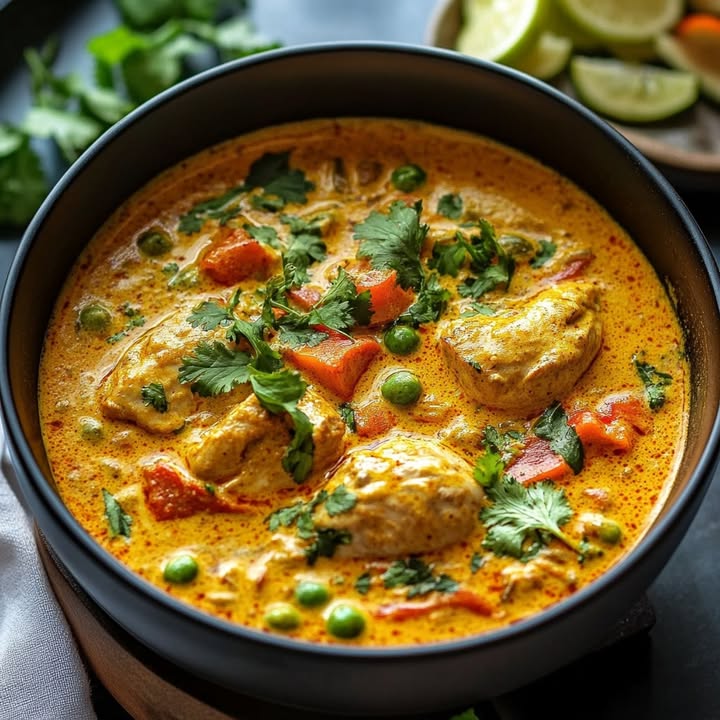
Let’s Take Your Taste Buds to Thailand Without Leaving Home
Picture this: a cozy evening at home, the smell of spices wafting through the air, and a bowl of creamy, dreamy Thai Coconut Curry in front of you. Sounds like a foodie’s dream, right? Well, I’ve got good news for you—this dish is not only delicious but also super easy to whip up. A few weeks ago, I made this recipe for my family during one of our lazy Sunday dinners. Everyone loved it so much, they were licking their plates clean (yes, even my picky-eater nephew!). With its vibrant flavors and comforting textures, this Thai Coconut Curry will transport you straight to the streets of Bangkok.
A Little History About This Creamy Delight
The origins of curry dishes trace back centuries in Southeast Asia, where cooks have long celebrated the marriage of bold spices with creamy coconut milk. In Thailand, curries are often prepared using fresh pastes made from chilies, lemongrass, garlic, and galangal—a cousin of ginger. These days, you can find ready-made curry pastes in most grocery stores, which makes recreating authentic Thai flavors a breeze. My version of Thai Coconut Curry stays true to tradition while keeping things simple enough for busy weeknights. Plus, it’s 100% halal, so everyone at your table can enjoy it guilt-free!
Why You’ll Fall Head Over Heels for This Recipe
There’s something magical about how the creamy lait de coco blends with the spicy kick of red curry paste. The tender chicken, sweet carrots, and wilted spinach create layers of flavor and texture that dance on your tongue. And let’s not forget the zesty lime juice and fragrant coriander sprinkled on top—it’s like a party in every bite! What’s more, this dish comes together in just 30 minutes, making it perfect for those nights when you want something impressive but don’t have hours to spend in the kitchen.
Perfect Occasions to Whip Up This Dish
- Weeknight Dinners: Quick, satisfying, and packed with nutrients.
- Dinner Parties: Impress guests with an exotic yet approachable meal.
- Potlucks: Bring a warm, comforting dish everyone will rave about.
- Rainy Days: Nothing beats a steaming bowl of curry when it’s cold outside.
Ingredients You’ll Need
- 2 to 3 tablespoons of coconut or olive oil
- 1 yellow or sweet onion, finely chopped
- 450 g boneless chicken breast, cut into chunks
- 3 cloves garlic, minced or pressed
- 2 to 3 teaspoons ground ginger (or 1 tablespoon fresh ginger)
- 2 teaspoons ground coriander
- 1 can (400 ml) coconut milk
- 1 to 1.5 cups grated carrots
- 1 to 3 tablespoons Thai red curry paste (adjust to taste)
- 1 teaspoon salt
- ½ teaspoon freshly ground black pepper
- 3 cups fresh spinach leaves
- 1 tablespoon lime juice
- 1 to 2 tablespoons brown sugar (optional)
- ¼ cup chopped fresh cilantro or basil
- Rice, quinoa, or naan bread for serving (optional)
Substitution Options
- Chicken: Swap with tofu, shrimp, or chickpeas for a vegetarian option.
- Coconut Oil: Use any neutral oil if you’re out of coconut oil.
- Carrots: Zucchini or bell peppers work as colorful alternatives.
- Spinach: Kale or Swiss chard can replace spinach.
- Brown Sugar: Honey or maple syrup works too.
Step 1: Sauté the Onions Until Golden
Heat your oil in a large skillet over medium-high heat. Add the finely chopped onion and sauté for about 5 minutes until soft and translucent. The aroma alone will make your stomach growl! Pro tip: Don’t rush this step; caramelizing the onions adds depth to the dish.
Step 2: Cook the Chicken Until Juicy
Toss in the chicken pieces and cook them for about 5 minutes until golden brown. Be careful not to overcrowd the pan, or the chicken might steam instead of sear. Keep stirring occasionally to ensure even cooking.
Step 3: Spice Things Up
Once the chicken is cooked, stir in the garlic, ginger, and coriander. Let these aromatic spices bloom for about a minute—you’ll know it’s ready when the scent fills your kitchen. Chef’s tip: Freshly grated ginger gives a brighter flavor than powdered.
Step 4: Build the Sauce
Pour in the coconut milk, add the grated carrots, curry paste, salt, and pepper. Stir everything together and let it simmer for 5 minutes. Watch how the sauce thickens slightly, coating the chicken beautifully. If you prefer milder spice levels, start with 1 tablespoon of curry paste and adjust later.
Step 5: Finish with Greens
Add the spinach and lime juice, then cook for another 1-2 minutes until the greens are wilted. Give it a final taste test and tweak the seasoning with brown sugar, salt, or extra curry paste if needed. Garnish with fresh cilantro before serving.
Timing Breakdown
- Prep Time: 10 minutes
- Cook Time: 20 minutes
- Total Time: 30 minutes
Chef’s Secret
To elevate your Thai Coconut Curry, toast the curry paste in the pan for 30 seconds before adding liquids. This unlocks its full flavor potential and makes the dish even more aromatic.
An Interesting Tidbit About Coconut Milk
Did you know that coconut milk has been used in Southeast Asian cuisine for centuries because of its rich texture and ability to balance spicy flavors? It’s like nature’s answer to heavy cream, minus the dairy!
Necessary Equipment
- Large skillet or frying pan
- Wooden spoon or spatula
- Measuring spoons and cups
- Knife and cutting board
Storage Tips
This Thai Coconut Curry keeps well in the fridge for up to 3 days. Store it in an airtight container to preserve its flavors. Reheat gently on the stovetop or in the microwave, adding a splash of water or coconut milk to loosen the sauce.
If freezing, portion the curry into individual servings and freeze for up to 2 months. Thaw overnight in the fridge before reheating.
Avoid storing leftovers with rice or naan, as these absorb moisture and lose their texture over time. Instead, keep them separate until ready to serve.
Tips and Advice
- Use high-quality curry paste for the best results.
- Don’t skip the lime juice—it adds brightness to the dish.
- Serve with jasmine rice for an authentic touch.
Presentation Ideas
- Garnish with extra cilantro or basil leaves.
- Drizzle a bit of chili oil for visual appeal.
- Serve in colorful bowls to highlight the vibrant ingredients.
Healthier Alternatives
Here are six ways to lighten up your Thai Coconut Curry:
- Low-Fat Version: Use light coconut milk instead of full-fat.
- Vegan Option: Replace chicken with tofu or lentils.
- Gluten-Free Twist: Serve with gluten-free rice noodles.
- Vegetable-Packed: Add broccoli, cauliflower, or peas.
- Protein Boost: Include boiled eggs or paneer cubes.
- No-Sugar Version: Omit the brown sugar and rely on natural sweetness from veggies.
Mistake 1: Using Too Much Curry Paste
It’s tempting to dump in lots of curry paste for maximum flavor, but this can overpower the dish. Start with 1 tablespoon, taste, and adjust gradually. Pro tip: Remember, you can always add more, but you can’t take it away!
Mistake 2: Skipping the Lime Juice
Lime juice balances the richness of the coconut milk and cuts through the spiciness. Forgetting it leaves the dish feeling flat. Always add it right before serving for freshness.
Mistake 3: Overcooking the Spinach
Spinach wilts quickly, so tossing it in too early turns it mushy. Add it in the last couple of minutes to retain its vibrant green color and delicate texture.
FAQs About Thai Coconut Curry
Can I make this dish vegan?
Absolutely! Simply swap the chicken for plant-based proteins like tofu or chickpeas, and use vegetable broth if needed. The result is just as flavorful and satisfying.
Is Thai red curry paste spicy?
Yes, it contains dried red chilies, but you can control the heat by adjusting the amount used. Most brands label their products as mild, medium, or hot, so choose accordingly.
What type of rice pairs best?
Jasmine rice is the classic choice due to its floral aroma and fluffy texture. However, basmati or brown rice also complement the dish nicely.
Can I use frozen spinach?
Yes, thaw and squeeze out excess water before adding it to the curry. Just note that fresh spinach offers better texture and flavor.
How do I store leftovers?
Keep them in an airtight container in the fridge for up to 3 days. Freeze portions for longer storage, but thaw properly before reheating.
What other vegetables can I add?
Feel free to toss in bell peppers, snap peas, or mushrooms. They all pair wonderfully with the creamy sauce.
Do I need special tools?
No fancy gadgets required—a good knife, cutting board, and skillet are all you need to whip up this delicious meal.
Why does my curry taste bland?
Chances are, you forgot the lime juice or didn’t season enough. Balance is key in Thai cuisine, so don’t shy away from salt, pepper, or a pinch of sugar.
Can kids enjoy this dish?
Of course! Adjust the spice level by reducing the curry paste, and serve it with plain rice to tone down the intensity.
Where can I buy Thai curry paste?
Most supermarkets carry it in the international aisle. Brands like Mae Ploy and Thai Kitchen are widely available and reliable options.
Final Thoughts
This Thai Coconut Curry isn’t just a recipe—it’s an experience. From the moment you start chopping onions to the first heavenly bite, you’ll feel connected to the rich culinary traditions of Thailand. Whether you’re cooking for yourself, your family, or friends, this dish promises to delight. So grab your apron, fire up the stove, and get ready to savor the magic of Thai flavors in under 30 minutes. Bon appétit!

Thai Coconut Curry
Ingredients
Equipment
Method
- Heat oil in a large skillet over medium-high heat and sauté the onion until golden.
- Add chicken pieces and cook until golden brown, stirring occasionally.
- Stir in garlic, ginger, and coriander; let it bloom for about a minute.
- Pour in coconut milk, add carrots, curry paste, salt, and pepper; stir and simmer for 5 minutes.
- Add spinach and lime juice, and cook until the spinach has wilted, then taste and adjust seasoning.
